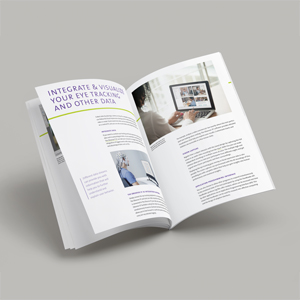How to increase attention in commercials for Gen-Z

Generation Z has the shortest attention span for commercials, yet they are becoming an increasingly important market segment. Understanding what captures their interest and how to engage them in commercials is crucial.
Posted by
Published on
Tue 16 Jul. 2024
Topics
| Attention | Consumer Behavior | Eye Tracking | FaceReader | FaceReader Online | Facial Expression Analysis |
This blog post was written by Pim Sommerdijk, who completed his Master's degree in Commercial communication in Communication Sciences at Radboud University in Nijmegen, The Netherlands. The thesis was supervised by Paul Ketelaar, Assistant Professor in Communication Science and the Behavioural Science Institute (BSI) at Radboud University.
Advertising avoidance
In today's saturated digital advertising landscape, the battle for consumer attention is fiercer than ever. Consumers increasingly avoid ads, perceiving them as intrusive, annoying, or boring1.

Generation Z has the shortest attention span for commercials, yet they are becoming an increasingly important market segment. Understanding what captures their interest and how to engage them in commercials is crucial for marketers aiming to compete in this competitive market and design effective ads2.
Learn more about tools for neuromarketing research.
Top-down and bottom-up visual attention processes
Advertising avoidance is a result of visual attention processes, where the brain determines which visual information is (un)consciously processed or ignored. Visual attention is driven by both top-down and bottom-up processes.
Top-down processes stem from conscious decisions such as motivation, while bottom-up processes are triggered by external automatic stimuli3 4. By strategically leveraging these two processes, advertisers can reduce the likelihood of consumers avoiding ads5 6.
This experimental study examined the effects of humor and audio-visual synchrony stimuli on the visual attention of Gen Z in commercials. Humor in advertising can play a crucial role in maintaining conscious attention, engaging top-down processes7 8. Additionally, synchronizing audio with visual elements in ads can automatically draw people's attention to these visuals, engaging bottom-up processes9 10.

Figure 1: This study examines the effects of humor and audiovisual synchronicity on visual attention when watching an advertisement.
Measuring visual attention with FaceReader Online
Using FaceReader Online eye tracking software enables real-time measurement of where and for how long individuals gaze at commercials, eliminating the need for post-viewing attention recall through survey questions. This is crucial in advertising, as consumers often engage with ads subconsciously11. To compare the results of both methods, this study utilized both survey questions and FaceReader Online to measure attention.
Creating ads with humor and audiovisual synchronicity
For the experiment, four commercials were created, each employing various combinations of humor and audio-visual synchrony. In the initial segment of the ads, humor manipulation involved adding or removing comedic elements from an existing commercial. Humor was manipulated in this segment to enhance engagement and alertness for the subsequent segment of the commercial.
Subsequently, a complementary second segment of the commercial was developed. Additional visuals were incorporated in a manner that demanded viewer attentiveness to notice, such as placing them in the corners of the screen. The idea behind this was that individuals exposed to a more humorous commercial would be more alert than those who were not, thus more likely to notice the additional visuals.
To manipulate audio-visual synchrony, sound effects were either synchronously or asynchronously added to the additional visuals in the second segment of the ads, aiming to test how audio-visual synchrony influences visual attention. Using eye tracking technology, the duration of gaze towards these additional visuals was measured among different groups, followed by result comparisons12.

Figure 2: How gaze directions where measured
Enhancing visual attention
An experiment involving 133 participants, aged 18 to 29 with an average age of 22, was conducted to study visual attention. Participants were randomly divided into four groups, each exposed to different combinations of humor and audio-visual synchronization in commercials. The study was conducted online via Qualtrics, requiring participants to use a webcam and the appropriate browser for the FaceReader software, which recorded their visual attention.
The survey began with demographic questions, followed by a two-commercial block, with the second commercial serving as the primary stimulus. FaceReader tracked participants' gaze directions during the commercial. Afterwards, they answered questions about their attention to specific areas of interest (AOIs).
The results of the study showed that commercials infused with a substantial dose of humor attract more visual attention compared to their less humorous counterparts. This underscores the potent role humor plays in capturing the attention of Generation Z. Additionally, it was observed that commercials in which visual and auditory elements synchronize receive more attention than those where that is not the case. Furthermore, the findings indicate that smartly combining both elements further enhances visual attention, surpassing the impact of using them separately.
You may also like to read about the effects of disclosures on sponsored or AI-generated content.
How FaceReader Online may provide new insights for measuring attention
While not the primary focus of the research, this study underscores the importance of utilizing eye tracking software for measuring visual attention. Eye tracking revealed significant effects of humor and sound synchronization, as well as their combination, whereas self-reporting showed no significant results.
In previous studies, attention has often been measured using self-report scales, but this method isn't always deemed accurate due to memory lapses and lack of engagement in self-reporting13. Additionally, cognitive processes elicited by commercials often occur unconsciously, making it challenging for consumers to consciously reflect upon them14. FaceReader Online holds significant promise in this regard, as it serves as a valuable tool to enhance understanding of attention by examining real-time screen-viewing data.
Also read: Why you should use FaceReader Online for your human behavior research.
Facilitating large-scale attention research
Finally, FaceReader Online is user-friendly, enabling the recruitment of a large number of participants. By integrating FaceReader with online surveys, it's easy to scale up your research. Participation is also convenient for respondents, as they can choose whether and when to participate in the study. This facilitates large-scale research.
Utilizing FaceReader Online allows us to enhance our understanding of attention, complement existing scientific knowledge and measurement methods, and gain valuable insights into the effects of attention.
References
1. Jeon, Y. A., Ryoo, Y., & Yoon, H. J. (2022). Increasing the Efficacy of Emotional Appeal Ads on Online Video-Watching Platforms: The Effects of Goals and Emotional Approach Tendency on Ad-Skipping Behavior. Journal Of Advertising, 53(1), 1–18. https://doi.org/10.1080/00913367.2022.2073299
2. Southgate, D. (2017). The Emergence of Generation Z And Its Impact in Advertising. Journal Of Advertising Research, 57(2), 227–235. https://doi.org/10.2501/jar-2017-028
3. Zhang, X., Fan, C., Yuan, S., & Peng, Z. (2015). An Advertisement Video Analysis System Based on Eye-Tracking. IEEE. https://doi.org/10.1109/smartcity.2015.118
4. Parkhurst, D., Law, K., & Niebur, E. (2002). Modeling the role of salience in the allocation of overt visual attention. Vision Research, 42(1), 107–123. https://doi.org/10.1016/s0042-6989(01)00250-4
5. Rosengren, S., Eisend, M., Koslow, S., & Dahlén, M. (2020). A Meta-Analysis of When and How Advertising Creativity Works. Journal Of Marketing, 84(6), 39–56. https://doi.org/10.1177/0022242920929288
6. Gordon, N., Tsuchiya, N., Koenig-Robert, R., & Hohwy, J. (2019). Expectation and attention increase the integration of top-down and bottom-up signals in perception through different pathways. PLoS Biology, 17(4), e3000233. https://doi.org/10.1371/journal.pbio.3000233
7. Strick, M., Van Baaren, R. B., Holland, R. W., & Van Knippenberg, A. (2009). Humor in advertisements enhances product liking by mere association. Journal Of Experimental Psychology: Applied, 15(1), 35–45. https://doi.org/10.1037/a0014812
8. Schmidt, S. R., & Williams, A. (2001). Memory for humorous cartoons. Memory & Cognition, 29(2), 305–311. https://doi.org/10.3758/bf03194924
9. Miller, J., Carlson, L., & McAuley, J. D. (2012). When what you hear influences when you see. Psychological Science, 24(1), 11–18. https://doi.org/10.1177/0956797612446707
10. Simmonds, L., Bogomolova, S., Kennedy, R., Nenycz‐Thiel, M., & Bellman, S. (2020). A dual‐process model of how incorporating audio‐visual sensory cues in video advertising promotes active attention. Psychology & Marketing, 37(8), 1057–1067. https://doi.org/10.1002/mar.21357
11. Vraga, E., Bode, L., & Troller-Renfree, S. (2016). Beyond Self-Reports: Using Eye Tracking to Measure Topic and Style Differences in Attention to Social Media Content. Communication Methods And Measures, 10(2–3), 149–164. https://doi.org/10.1080/19312458.2016.1150443
12. Zhang, X., & Yuan, S. (2018). An Eye Tracking Analysis for Video Advertising: Relationship Between Advertisement Elements and Effectiveness. IEEE Access, 6, 10699–10707. https://doi.org/10.1109/access.2018.2802206
13. Badejo, M. A., Ramtin, S., Rossano, A., Ring, D., Koenig, K., & Crijns, T. J. (2022). Does Adjusting for Social Desirability Reduce Ceiling Effects and Increase Variation of Patient-Reported Experience Measures? Journal Of Patient Experience, 9, 237437352210791. https://doi.org/10.1177/23743735221079144
14. Greene, B. A. (2015). Measuring Cognitive Engagement With Self-Report Scales: Reflections From Over 20 Years of Research. Educational Psychologist :/Educational Psychologist, 50(1), 14–30. https://doi.org/10.1080/00461520.2014.989230
Related Posts

Design your own product: consumer experience and abandonment behavior

Consumer research – what determines food satisfaction?

